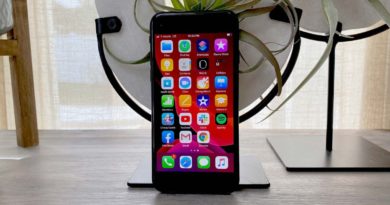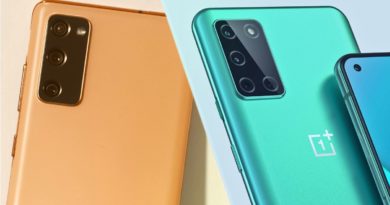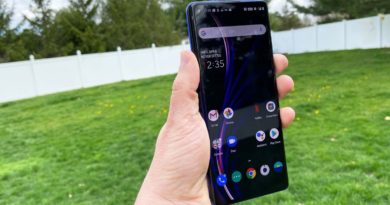Best small phones of 2020: Top picks under 6 inches
![]()
With smartphone screens stretching to nearly 7 inches these days, finding one of the best small phones to fit snugly in one hand has become increasingly difficult. Fortunately, there are still compelling options out there — you just have to know where to look.
If you believe good things come in compact packages, you’d be well advised to explore Apple’s range, as the iPhone maker continues to dominate the market for small phones with a number of good choices — including the newly-unveiled successor to the iPhone SE. Samsung and Google are also keeping the segment alive with devices that are both pocketable and affordable.
A notable advantage to choosing a small phone is that they typically cost less than Plus- or Max-sized versions of the same device, so you won’t be penalized by having to pay more for a handset that easily fits into your lifestyle.
However, one thing you won’t find on this list — at least, not yet — are any 5G phones. That’s because devices with 5G connectivity at this early stage tend to be larger, to accommodate the radios and antennas necessary for those networks. 5G phones also typically consume more power than their LTE counterparts, so the batteries have to be bigger as well.
What are the best small phones?
Small phone lovers who were also interested in snagging one of the best iPhones didn’t have many reasonable options until late. Thankfully, that’s changed now that the second-generation iPhone SE is now on the market, repurposing the iPhone 8’s 4.7-inch design with Apple’s latest A13 Bionic silicon for just $400.
But if a 4.7-inch phone is too small for you, the next-smallest iPhone is the iPhone 11 Pro, at 5.8 inches. This device is more compact than you might think, because it lacks the iPhone SE’s bezels and pushes its display all the way to the corners. However, it’s also $600 more expensive, so it isn’t the best alternative for anyone attracted to the SE’s low price (even though the iPhone 11 Pro is obviously still a fantastic smartphone).
If you’re looking for a small phone that runs Android, you may prefer the Pixel 4, which packs new features like secure facial identification and a state-of-the-art dual-lens camera system behind a 5.7-inch, 90 Hz display. You’d also be wise to check out the Galaxy S10e, which technically has a larger screen than Google’s offering but is actually much more compact, thanks to its smaller bezels. And if you’re phone hunting on a budget, you’ll find a lot to love in Google’s $399, 5.6-inch Pixel 3a. (A successor — the Pixel 4a — will reportedly launch in mid-July.)
Here’s a closer look at some of the best small phones out there right now, with screens sized at or under 6 inches. For our overall favorite handsets regardless of size, be sure to take a peek at our list of the best phones available today.
The best small phones you can buy today
1. iPhone SE (2020)
The best small phone (and one of the cheapest, too)
Display: 4.7-inch LCD (1334×750) | CPU: A13 Bionic | RAM: 3GB | Storage/Expandable: 64GB, 128GB, 256GB / No | Rear camera: 12MP wide (ƒ/1.8) | Front camera: 7MP (ƒ/2.2) | Weight: 5.22 ounces
Very affordable
Fast A13 Bionic performance
Excellent camera for the price
Supports wireless charging
Big bezels
They just don’t make fast, premium small phones like the new iPhone SE anymore. This diminutive 4.7-inch handset packs Apple’s best mobile processor — the lightning-quick A13 Bionic — despite the fact that it costs $300 less than the next most-expensive phone the company sells, the $699 iPhone 11.
It also brings more luxuries you rarely see in small and cheap phones, like wireless charging, IP67 water resistance and a premium metal-and-glass design. While most flagship phone makers have shunned developing high-end handsets with displays smaller than about 5.5 inches, the iPhone SE feels like a blast from the past in the best way possible — a time when you could buy a super small phone with big-time performance. It might not have the flashiest-looking design or a camera equipped with the Night Mode present in pricier iPhones, but the new SE handles just about everything else flawlessly.
Read our full iPhone SE 2020 review.
2. iPhone 11 Pro
The best premium small iPhone
Display: 5.8-inch OLED (2436×1125) | CPU: A13 Bionic | RAM: 4GB | Storage/Expandable: 64GB, 256GB, 512GB / No | Rear camera: 12MP wide (ƒ/1.8); 12MP ultrawide (ƒ/2.4); 12MP 2X telephoto (ƒ/2.0) | Front camera: 12MP (ƒ/2.2) | Weight: 6.63 ounces | Battery life (Hrs:Mins): 10:24
Gorgeous OLED display now brighter
A13 Bionic CPU fastest around
Stellar triple cameras with Night Mode
Longest battery life of any iPhone
64GB of base storage
The 5.8-inch iPhone 11 Pro is no longer the smallest new iPhone you can buy, though it remains one of the best and fastest smartphones around if you can afford the privilege. Just like the 6.1-inch iPhone 11 and 6.5-inch iPhone 11 Pro Max, it’s powered by Apple’s state-of-the-art A13 Bionic chipset, which is powerful enough to enable unprecedented higher-order machine learning capabilities.
The iPhone 11 Pro leverages the A13’s power to pull off some stunning photography tricks, like Semantic Rendering, which recognizes different objects in a scene and intelligently exposes each uniquely, for a better result.
This iPhone also marks Apple’s first with its Super Retina XDR display: an OLED panel that topped an almost unbelievable 752 nits of peak brightness in our lab testing. Couple all that with the added convenience of Face ID, the versatility of a new ultrawide lens and 18W fast charging out of the box, and the iPhone 11 Pro is an all-around remarkable flagship handset — especially for those who prefer phones that are small (but not too small).
However, one point to note: It’s been long rumored that the entry-level version of the upcoming iPhone 12 will have a 5.4-inch display. Insiders suggest Apple is looking to make the bezels and notch on its next flagships even more slender than on the iPhone 11 Pro, so it’s quite possible the iPhone 12 will be a better fit for small phone lovers — meaning you may want to hold out a few more months.
Read our full iPhone 11 Pro review.
3. Google Pixel 4
The best small Android phone
Display: 5.7-inch OLED (2280×1080) | CPU: Snapdragon 855 | RAM: 4GB | Storage / Expandable: 64GB, 128GB / No | Rear camera: 12.2MP wide (ƒ/1.7); 16MP telephoto (ƒ/2.4) | Front camera: 8MP (ƒ/2.0) | Weight: 5.71 ounces | Battery life (Hrs:Mins): 8:03
Class-leading cameras
Smooth 90Hz display
Effective Face Unlock
Clever AI software features
Poor battery life
At 5.7 inches, Google’s new Pixel 4 isn’t an especially small phone — though it is significantly more pocketable than many top-line flagships today, including the iPhone 11 and the OnePlus 8. With the Pixel 4, Google’s trimmed out the bottom bezel, while leaving the Pixel 3’s forehead intact, and repurposing that space for a sophisticated Face Unlock feature that rivals Apple’s Face ID in terms of security. The top bezel is also where the Pixel 4’s Soli radar system is stored, so the device can respond to hand gestures in midair.
But this being a Pixel, the biggest improvements have been levied at the camera, as you’d expect. The Pixel 4 features Google’s first dual-lens imaging system, partnering a telephoto lens with a standard wide angle one for improved zoom shots. Our lone complaint about the Pixel 4 lies with the device’s poor battery life; at just 8 hours, it’s far and away eclipsed by the iPhone 11 series, and an eternity away from the handsets with the best phone battery life. But if you can deal with that, the Pixel 4 will delight you with its clever uses of machine learning and stunning photography.
Read our full Google Pixel 4 review.
4. Samsung Galaxy S10e
The most compact flagship you can buy
Display: 5.8-inch OLED (2160×1080) | CPU: Snapdragon 855 | RAM: 6GB, 8GB | Storage / Expandable: 128GB, 256GB / Yes | Rear camera: 12MP wide (ƒ/1.5, ƒ/2.4); 16MP ultrawide (ƒ/2.2) | Front camera: 10MP wide (ƒ/1.9) | Weight: 5.29 ounces | Battery life (Hrs:Mins): 9:21
Incredible display
Delightful, compact design
Headphone jack
Cameras could be better
Battery life is so-so
The Galaxy S10e is a different kind of flagship phone from Samsung. At $749 when new, the S10e was a bit cheaper than the 6.1-inch S10 and 6.4-inch S10 Plus, which started at $899 and $999, respectively. There are a few concessions for that lower price — namely a dual rear camera setup instead of a triple one, and a side-mounted fingerprint sensor replacing the regular S10’s in-display technology.
Yet the S10e is every bit as powerful and fast as its more expensive S10 siblings, despite the fact that it’s also one of the best small phones available. The handset’s 5.8-inch Dynamic AMOLED panel is quite large, but because it’s wrapped in a body with extremely slim bezels, the result is one of the most compact premium phones on the market today.
The Galaxy S20 may be the newest Samsung flagship on the market, but it doesn’t grant performance in this tiny a package. But an even better reason why you should opt for last year’s smallest premium Galaxy is its price: these days, you can nab an unlocked version from Samsung’s website for just $599.
Read our full Samsung Galaxy S10e review.
5. Google Pixel 3a
The best small budget Android phone
Display: 5.6-inch OLED (2280×1080) | CPU: Snapdragon 670 | RAM: 4GB | Storage / Expandable: 64GB / No | Rear camera: 12MP (ƒ/1.8) | Front camera: 8MP (ƒ/2.0) | Weight: 5.2 ounces | Battery life (Hrs:Mins): 11:59
Flagship-caliber camera
Includes headphone jack
OLED display
Low price
Performance is good, not great
So you want an all-around great smartphone with a camera that would put most flagship shooters to shame, but you don’t want to pay more than $400 for it. In the past, requesting such a device might get you laughed out of the retailer of your choosing, but then Google introduced the Pixel 3a and suddenly, everything changed.
The 5.6-inch Pixel 3a (and its larger sibling, the 6-inch Pixel 3a XL) touts the same 12.2-megapixel rear camera in Google’s premium smartphones, along with an OLED display, long-lasting battery and the latest and greatest Android software. However, it costs only $399 — half the price of the Pixel 3.
You do lose out on some amenities, like the Pixel 3’s top-tier Snapdragon 845 processor, wide-angle front-facing camera, water resistance and wireless charging. Still, the rest of the Pixel 3a is far better than its midrange price tag would suggest, and until the new iPhone SE came out, it was far and away our top pick for a handset under $400. All that said, with the Pixel 4a likely mere weeks away, you’re best advised to hold off purchasing one, at least until we’ve seen the 3a’s successor in the flesh.
Read our full Google Pixel 3a review.
6. Samsung Galaxy Note 10
The smallest phone with the biggest screen
Display: 6.3-inch AMOLED (2280×1080) | CPU: Snapdragon 855 | RAM: 8GB | Storage / Expandable: 256GB / No | Rear camera: 12MP wide (ƒ/1.5, ƒ/2.4); 16MP ultrawide (ƒ/2.2); 12MP 2X telephoto (ƒ/2.1) | Front camera: 10MP (ƒ/2.2) | Weight: 5.9 ounces | Battery life (Hrs:Mins): 9:25
Compact design with huge display
256GB storage standard
Live Focus now for video
No headphone jack or microSD
Battery life a bit underwhelming
We know what you’re thinking — a 6.3-inch smartphone is not small, and doesn’t even adhere to the criteria of this list! We understand, but take our word for it: the Galaxy Note 10 is more compact than you’d ever imagine, and it’s all thanks to the phone’s miniscule bezels, which deliver an all-screen experience in the truest sense. Plus, the panel Samsung shoehorned into its latest phablet is a beaut — a rich Dynamic AMOLED display with curved edges, shrouded in shatter-resistant Gorilla Glass 6.
Under the hood, the Note 10 boasts Qualcomm’s latest premium processor as you’d expect, as well as a sizable 3,500-mAh battery fitted with Samsung’s new 25-watt fast charging technology. Meanwhile, the S Pen has learned some clever new air gestures that allow you to navigate the phone simply by waving the stylus in front of the screen.
If you’ve ever been intrigued by the productivity potential of the Note series, but the device’s prohibitively large proportions put you off, the Note 10 is definitely for you. For what it’s worth, the Galaxy Note 20 is on the way, though given that it’s been tipped to have a larger 6.42-inch screen, we don’t anticipate it’ll be quite compact enough to sneak into our ranking of the best small phones.
Read our full Samsung Galaxy Note 10 review.
7. Samsung Galaxy S9
A great small flagship now on the cheap
Display: 5.8-inch AMOLED (2960×1440) | CPU: Snapdragon 845 | RAM: 4GB | Storage / Expandable: 64GB, 128GB, 256GB / Yes | Rear camera: 12MP wide (ƒ/1.5, ƒ/2.4) | Front camera: 8MP (ƒ/1.7) | Weight: 5.8 ounces | Battery life (Hrs:Mins): 10:52
Bright, colorful display
Great battery life
Includes headphone jack
AR Emoji is dismal
Bixby isn’t useful
A screen measuring 5.8 inches doesn’t sound like it would make for a particularly small phone. But what you have to remember is that the Galaxy S9 isn’t like other phones — and that’s all thanks to its wraparound Infinity Display. Samsung’s ability to curve its OLED panel around the sides, while trimming the bezels above and below, allows the Galaxy S9 to shoehorn a massive display into a very compact form factor. In other words, you’re not sacrificing on screen size for comfortable one-handed operation.
It also helps that the panel itself is among the brightest and most vibrant in its class (only eclipsed by the newer Galaxy S ranges, as well as Apple’s latest iPhones) and that the Galaxy S9 still boasts respectable performance and photography even though it first released in 2018, between its speedy Snapdragon 845 processor and solid photography in low light. Best of all, you can snag a new one for as little as $449 from Best Buy now that the S9 has just rounded its second birthday.
Read our full Samsung Galaxy S9 review.
How to choose the best small phone for you
You usually have to sacrifice something when buying a small phone. Of course, screen real estate is part of the tradeoff; but small phones also have smaller batteries, and sometimes less RAM or fewer camera lenses than larger, more expensive versions of the same device.
If you prioritize a compact form factor over all else — and you probably do if you’re reading this page — these tradeoffs will likely be well worth it. Apple and Google are featured prominently on our list of the best small phones because they don’t eliminate critical features from more compact handsets. That’s illustrated by the fact that the brand-new iPhone SE utilizes the same A13 Bionic chipset found in more premium Apple handsets, and how the Pixel 4 uses the same great dual-lens camera hardware as the larger Pixel 4 XL.
Samsung, on the other hand, usually scrubs something from their smaller models. The Galaxy S10e, which has a dual-lens camera compared to the triple-lens module inside the company’s Galaxy S10 and S10 Plus devices, is a prime example of that. The S10e also lacks an in-screen fingerprint sensor and has less RAM than its bigger, pricier siblings. Alas, that’s the price you pay for wanting a phone that can fit in your pocket in 2020.
How we test smartphones
In order for a smartphone — any smartphone, and not just the best small phones — to make our list, it needs to excel on several tests that we run on every handset. We perform some of these tests in our labs and some in the real world.
When it comes to performance, we rely on such synthetic benchmarks as Geekbench 5 and GFXBench to measure graphics performance. These tests allow us to compare performance across iPhones and Android devices. We also run a real-world video transcoding test on each phone using the Adobe Premiere Rush app and time the result.
To measure the quality of a phone’s display, we perform lab tests to determine the brightness of the panel (in nits), as well as how colorful each screen is (DCI-P3 color gamut). In these cases, higher numbers are better. We also measure color accuracy of each panel with a Delta-E rating, where lower numbers are better and score of 0 is perfect.
One of the most important tests we run is the Tom’s Guide battery test. We run a web surfing test over 5G or 4G at 150 nits of screen brightness until the battery gives out. In general, a phone that lasts 10 hours or more is good, and anything above 11 hours makes our list of the best phone battery life.
Last but not least, we take the best phones out in the field to take photos outdoors, indoors and at night in low light to see how they perform versus their closest competitors. We take shots of landscapes, food, portraits and more, and also allow you to be the judge with side-by-side comparisons in our reviews.


